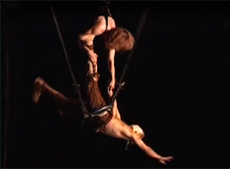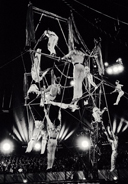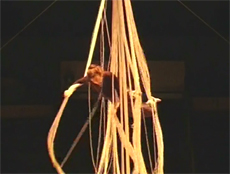by Magali Sizorn
Stretching flight time, dropping without falling, diving, turning and then starting all over again… Elastics are acrobatic and fun, incredible and dreamlike
For the fun of it
A recent apparatus in the history of the circus, elastics arose from a desire to extend acrobatics in the mid-1980s. Claude Lergenmuller (Les élastonautes company) was part of Michel Nowak's Noctambules company, which proposed street theatre that borrowed from parades and circus numbers. He was a musician, a trapeze artist and a seasoned sportsman (gymnastics, diving, acrobatic skiing) and imagined different ways of moving in the air. Between 1984 and 1985, when techniques were being developed in snow sports, about the pleasure of the instant, breaking with the model of head-to-head sports, he took inspiration from tightrope walkers to create a first unicycle number in which the balance artist climbs out of the ground.
To develop the technique, and moreover to design materials adapted to aerial acrobatics, the ingenious acrobat partnered up with some adventurous industrials. It would take three years of research to create the correct weave from pure rubber, in a perfect balance between length and yield for propelling acrobats. The factory workers still remember the tests.
Less painful than the trapeze, which marks the skin, and less gymnastic than the rings, the elastics both suspend flight and bring you back to the ground. Stretched or tucked body rotations, solo or group aerial figures and other acrobatic explorations became possible in this halfway form in which the fear of an accident is almost non-existent.
Propulsion and immersion
Attached at the waist by a harness linked to two elastics, the flyer can move vertically in space, or backwards and forwards to carry out rotations around a transverse axis. Playing with his weight to move gracefully, swinging between propulsion and gravitational gliding, he can enjoy a longer amount of time in the air than on other apparatus, prolonging the suspension in a never-ending rebound.
As though they were in water, the acrobats are seemingly immersed in the air in an experiential matrix (Andrieu, 2011). The elastics make them into hybrids, postmodern combatants in the dome of Mad Max 3 (1985), birdmen and women in the famous aerial ballet of the opening ceremony of the Albertville Winter Olympics (1992). Directed by Philippe Découflé, taking up the final movement of a Claude Lergenmuller creation, this tableau of propeller-flyer duos evoked both bird flight and snowflakes, in trajectories designed starting at the carrousel holding the apparatus.
A combination of sensations, technological ingeniousness and high drama, the exercise was broadly taken up in shows of various registers such as Trapèze dans l’azur, by the Cirque Baroque (1989), Toiles, by the Cirque Plume (1993), FantAsie (2004) by the Arlette Grüss circus – an aerial ballet on elastics, recalling that so-called "traditional" circuses remain forums for valorising innovation. In addition there was Journey of Man, a Cirque du Soleil film (2000) that took up the elastics and trapeze numbers from Saltimbanco (1992), with a foursome on elastics and trapeze in the middle of a forest, the aerial counterpart to another immersive synchronised swimming number.
From the abyss to paradise
Elastic cord jumping, or bungee jumping, also appeared in the 1980s, offering an experience of jumping into a void, suspended by an elastic cord tied around the ankles. This was a close encounter with death by plunging into the abyss, which had meaning, and not the oscillation allowed by suspension. A modern “ordalique” ritual1 (Le Breton, 2002), and metaphorical ordeal of confronting the limits of life, bungee jumping evokes the traditional rites of passage of young men in Vanuatu who jump from a wooden tower (gol) and brush the ground, suspended from a liana tied around their ankles. The liana could break at any moment and lead to death.
These elastic cord practices, which are very close to body techniques and uses, also evoke different values and imaginations. Here, the circus is above all about a show of dreams in matrix form, and the line between illusion and reality.
1. Describes behavior that has an element of mortal risk, by which the subject tries to master his destiny.









